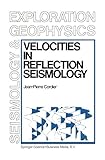Velocities in reflection seismology [Libro electrónico] / Jean-Pierre Cordier
Por: Cordier, Jean-Pierre [autor/a].
Tipo de material: Libro
en línea Editor: Dordrecht: Springer science, c1985Descripción: xii, 201 páginas : gráf. ; centímetros.ISBN: 9048184169; 9789048184163; 9789401736411 (Online).Nota de acceso: Disponible para usuarios de ECOSUR con su clave de acceso Nota de bibliografía: Incluye bibliografía: páginas 199-201 e índice Número de sistema: 57522Resumen:
Libro
en línea Editor: Dordrecht: Springer science, c1985Descripción: xii, 201 páginas : gráf. ; centímetros.ISBN: 9048184169; 9789048184163; 9789401736411 (Online).Nota de acceso: Disponible para usuarios de ECOSUR con su clave de acceso Nota de bibliografía: Incluye bibliografía: páginas 199-201 e índice Número de sistema: 57522Resumen:| Tipo de ítem | Biblioteca actual | Colección | Signatura | Estado | Fecha de vencimiento | Código de barras |
|---|---|---|---|---|---|---|
| Libros | Biblioteca Electrónica Recursos en línea (RE) | Acervo General | Recurso digital | ECO400575223436 |
Incluye bibliografía: páginas 199-201 e índice
Disponible para usuarios de ECOSUR con su clave de acceso
Although considera bIe efforts are now being made to find new sources of energy, alI the experts are agreed that hydrocarbons will have to provide the greater part of our energy needs for a generation ahead. Exploration for and production of hydrocarbons therefore pose a serious problem for our future, as much for the quantitative satisfaction of our requirements as for our search for self-sufficiency in energy. As a direct result of improvements in technology throughout the world, geophysics has progressively enlarged its field of influence in the realms of exploration and production. But amongst the various geophysical methods available, seismic reflection has gradually become accepted as the basic tool of the oiI prospector. Reflection seismology has reached and consolidated this position because it has shown itself to be capable of adapting to the increasing complexity of the requirements of exploration. Initially directed towards geometric mapping of the sub-surface, it became the means of detection of structural traps in geotectonically quiescent regions, and thereafter in increasingly complex surroundings. It has enabled us to clothe the structural framework with a lithology, initially approximate, but becoming more and more precise, assisting the explorer to locate stratigraphic traps. Further developments enable us under favourable circumstances to estimate the quality of the deposits and to detect the presence of fluids and of their interfaces; it then becomes an unrivalled tool for the producer, both in the development of deposits and in the application of enhanced recovery methods. eng
Disponible en línea
Disponible en formato PDF
Subscripción a ELSEVIER 26 de diciembre del 2013
